Now & New
Hanamichi Onomichi, Part Two: Pedaling Across the Prefectural Border
Previously, on Hanamichi Onomichi, I took a stroll across Onomichi, hitting up the seven main temples to scope out the situation on the cherry blossoms. As the number of sakura in bloom was too low, I decided to expand my sakura search southward from Honshu to the islands of the Shimanami Kaido. Three of the six islands on the Shimanami Kaido are within the city limits of Onomichi, and besides driving, cycling across the islands is another popular way to explore them. It was still early afternoon by the time I had finished visiting the seven sites of my Temple Walk, and with nothing but dry skies from here on out, I was raring to face the cycling road head on. So much so, in fact, that I wouldn’t stop at the city limits of Onomichi; I was determined to put the pedal to the metal all the way to Imabari on the island of Shikoku, photographing flowers and other scenic points of interest along the way.
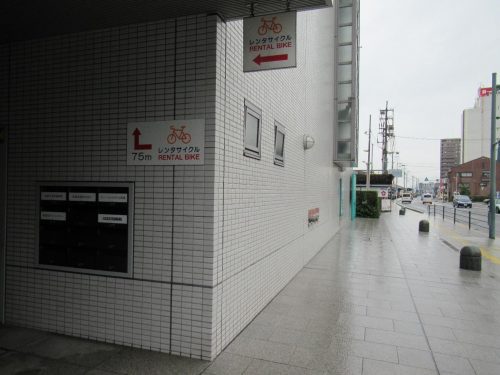
Having returned to Onomichi Station from the Temple Walk, I crossed the street to the seaside, then walked west in the direction of the Green Hill Hotel Onomichi until I saw signs pointing me towards the Bicycle Rental Terminal. There, hundreds of bikes are stored on the first floor of a parking garage, waiting for a human to take them out for a spin. Reservations aren’t necessary to rent as there are usually more than enough bicycles available to satisfy tourist demand, but over long breaks such as Golden Week and Obon, one would do well to book a bike in advance, just in case. Helmets are also available free of charge in limited quantities, though choosy and paranoid old me opted to bring one from home. The bike rental set me back ¥5,100–¥2,000 per day as I would spend the night on one of the islands, and a fee of ¥1,100 to deposit the bike at a different terminal as I wouldn’t be biking back to Onomichi after reaching Imabari. After I paid and signed the paperwork, I was allowed to walk around the garage and pick a set of wheels for my pedaling pilgrimage. I went with this green one since it seemed reliable and the color matched my jacket.
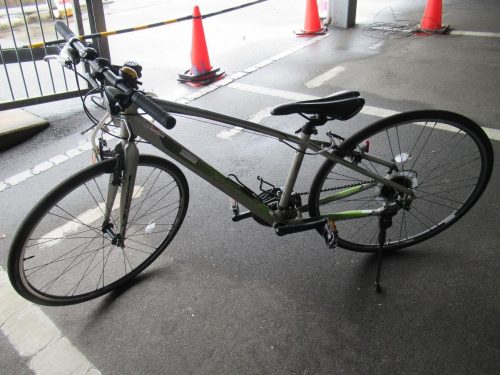
I pushed my two-wheeled companion back to the counter, put on my helmet, and listened to some more explanations while they handed me a guide map of the Shimanami Kaido. They tell tourists what number to dial in an emergency, who to contact depending on what island they’re on, at what points the bicycle can be returned, and so forth. The staff there may not speak English, but documentation and maps are available in English if required. When all was said and done, off I went in the direction of the first island on the cycling road: Mukaishima. To get there, simply get on your bike (or push it, since it’s not far) and head to the pier, where a ferry will take you there. There are no (bicycle-friendly) bridges nearby, so this is pretty much your only option; the fare is ¥110 and everyone pays on board.
向島 (Mukaishima): Orchids Galore

The Shimanami Kaido cycling road is marked by a blue line on the street from the port of Mukaishima all the way to Imabari Station on Shikoku, so cyclists won’t ever be lost for long (I’ll eat my words later). At the start of my voyage, I found some convenience stores here and there to stock up on provisions before sticking to the blue line. Most cyclists usually go counter-clockwise along the coast to the first bridge, but as this was not my first time attempting this challenge, I instead made my goal a different destination: the Mukaishima Orchid Center, where I could enjoy a hanami with a different type of flower. It was a steep climb up some hilly terrain, and the rain even started up again, but I eventually made it to the Orchid Center. As expected, the cherry blossoms weren’t blooming on the trees outside, but in this case, it’s what’s on the inside that counts, right?
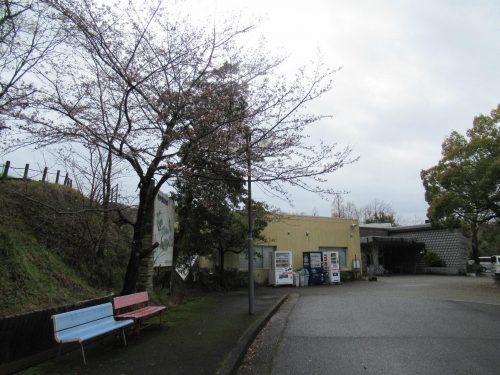
Upon locking my bike and going through the front entrance, there was a door to my right, leading to the gift shop. Inside, they had a huge variety of orchids on display and for sale. These potted ones with the wide-open, forward-facing, colorful flowers and the type I usually see inside newly-opened businesses that are donated by their supporters; I wonder if this shop caters to that type of clientele. Simply taking pictures of the plants without purchasing is permitted, but as the aisles are narrow, those with backpacks should exercise caution when perusing and navigating the store.

Outside the store was a spacious garden area where visitors can feed the fish, buy snacks, relax on one of the benches, and view the orchids in their natural setting. It must not have been orchid season since the flowers outside didn’t look good enough to appear in this article, but one thing that surprised me was a radiantly blooming cherry tree with vivid, white petals. For better or worse, this was the one good cherry tree I found on all of Mukaishima that day.
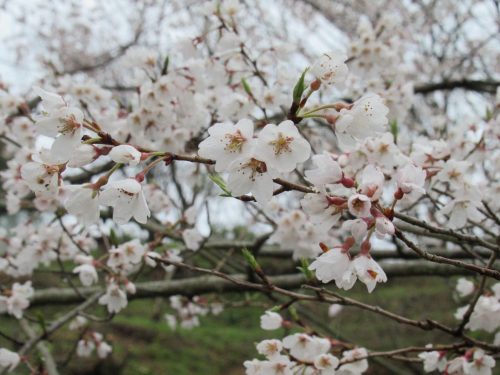
I was ravenous after having biked this far, so I plopped down underneath a gazebo and tore into the snacks I had bought earlier. “That should last me until I reach my hotel on Innoshima,” I thought. After realizing that time was not on my side, I promptly set out for the cycling road once again.

There are plenty of other sites to enjoy on this island, including a chocolatier and a great number of cafés, but since I wanted to make it to my hotel before sundown, my primary goal was the Innoshima Bridge, which would take me to the next island. Just a note to the would-be cyclists out there: when wanting to access the bridges, keep an eye out for where the access ramps are, because they aren’t always near the bridge. For instance, when I was this far from the bridge, I had unknowingly passed the access ramp and had to turn back. These bridge entrances may not always be conspicuous, but keep your eyes peeled for the blue line going uphill, coupled with some yellow markers to regulate speed and enforce lanes of traffic.
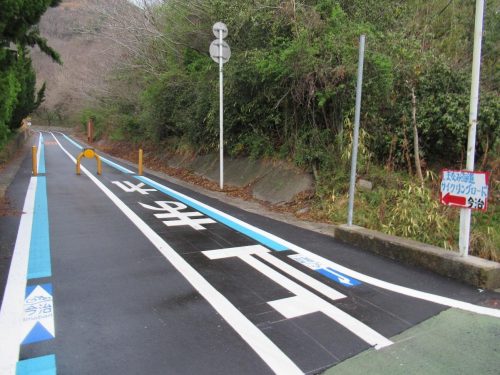
This bridge in particular was quite noteworthy in that rather than having cyclists go alongside cars on top, cyclists and pedestrians instead travel in a caged lane underneath automobile traffic. The caged setting takes away from the scenic feel just a little bit, but at least we can see the vast Seto Inland Sea outside on either side, and our eyes should be focused in front anyway. Marks on the road remind travelers of the lanes of traffic, and a message telling cyclists to slow down can be found at either end of the bridge.
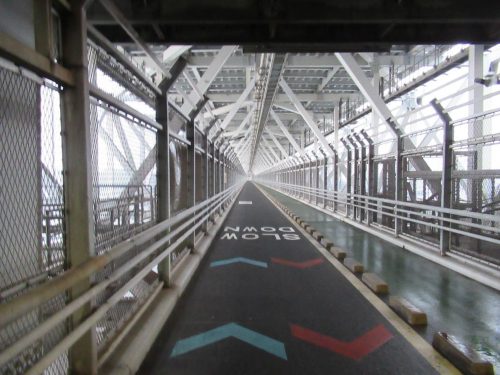
因島 (Innoshima): Strike One
In a nutshell, by the time I got to Innoshima, I was racing against the setting sun trying to find my hotel, and all the wrong turns I was making didn’t help. My lodging was around the Innoshima Park area, supposedly best accessed via a path that wasn’t on the official cycling road, thus there was no blue line telling me which way to go. When it got too dark for me to safely ride, in an act of desperation, I called my hotel asking to be rescued. My place was phenomenal in that once the lady on the other end of the line ascertained my whereabouts, she herself drove over to my location to scoop me up and not only escort me to the hotel, but even let me stop by a convenience store to grab dinner since the hotel’s restaurant was already closed. They only rescued me that night; they would deliver my locked bike to the hotel lobby the next morning. After I arrived at my lodging and checked in, I ate dinner, took a soak in their hot spring, and got some much-needed shut-eye.
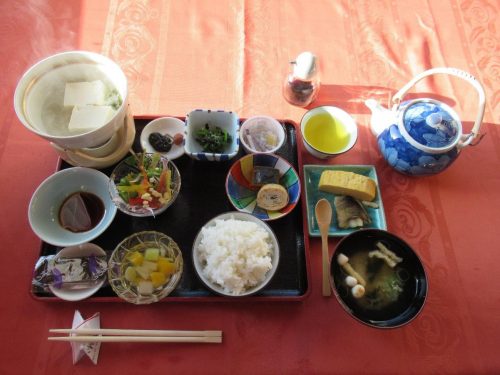
I awoke to the above spread the next morning, which I trusted would last me until lunch time (I was mistaken). There were vegetables of all kinds alongside fish, rolled omelet, boiled tofu, fruit cocktail, miso soup, and free refills on steamed rice. The vista I had before me as I scarfed down breakfast honestly couldn’t be beat; reserving this hotel was the right move in spite of not being able to reach it last night.
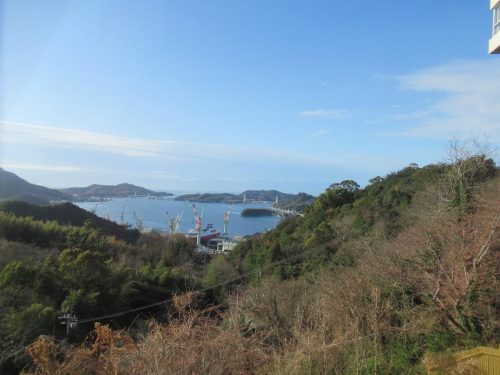
After breakfast, I went back to my room to finalize packing, reserve my bus from Imabari back to Hiroshima over the phone, and rest one final time before continuing my arduous journey by bike. My hotel was located right next to Innoshima park, so after checking out, I took a short walk through to see what views it offered. The state of the sakura here wasn’t anything to write home about, but the view of the Ikuchi Bridge in the distance–my next goal–inspired me to put my all into the ride once again.
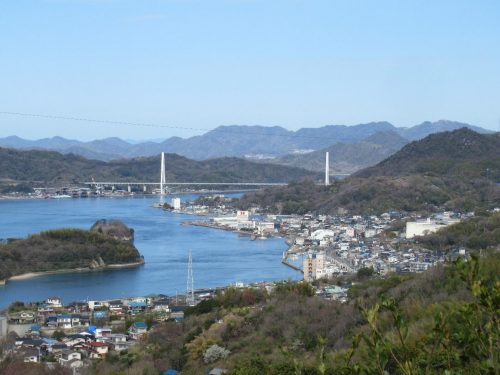
Moment of Joy: Second Wind
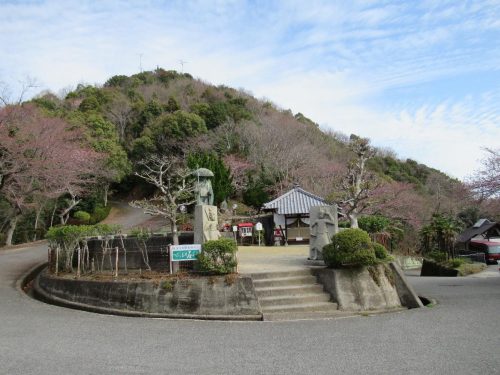
Back on my bike, I turned right to head down to sea level. The hill on which this hotel is located is rather steep, so there was no need to pedal as gravity had me on cruise control. It felt like a makeshift roller coaster, and I enjoyed every second of it. By the time I was down at sea level, I had the confidence I needed to tackle the rest of the Shimanami Kaido, however long it would take.
生口島 (Ikuchijima): Last Frontier of Onomichi
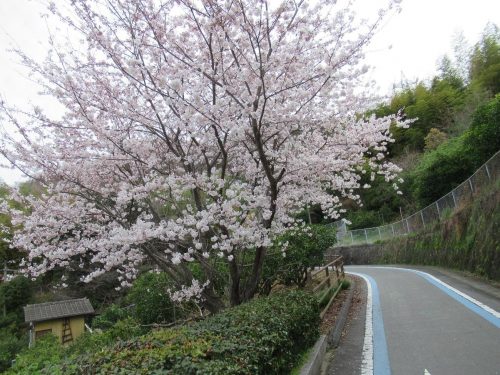
Cycling as I could through Habu Port, I soon reached the access ramp for the Ikuchi Bridge, where a big cherry tree brimming with blossoms gave me a warm welcome. I sped across the bridge to Ikuchi Island, the third one down from the mainland, and home to many a tourist attraction. There’s Kosanji, a modern Buddhist temple that only looks traditional, and Sunset Beach, a scenic area that’s best visited at dusk, and the Ikuo Hirayama Museum, where I decided to park my bike and have a look. The exhibition on display at the time was images of Raijin and Fujin, and as much as I wanted to see them, I was in a hurry and didn’t have time to go inside. Instead, I stayed in the front garden and photographed some gorgeous sakura.
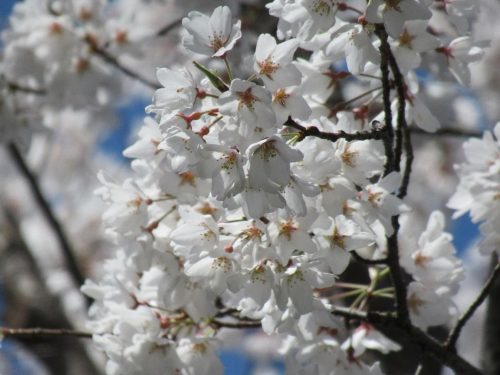
After that, it was onto the Shiomachi Shopping Street to search for a bite to eat as I was getting queasy from hunger (that breakfast wasn’t enough)! There were only a few restaurants on the street itself–the rest of the businesses only sold snacks and souvenirs–and the fare was too simple and light to pique my interest. It could be that some of the other restaurants are closed during the day and only open for dinner.
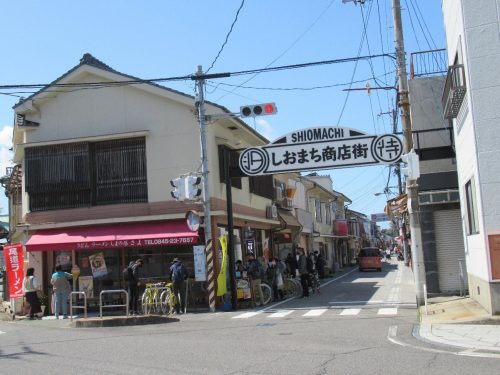
In spite of all the interesting items for sale on Shiomachi, the street itself isn’t much to look at save for some ornate manhole covers advertising scenes from the Shimanami Kaido I was currently traversing.
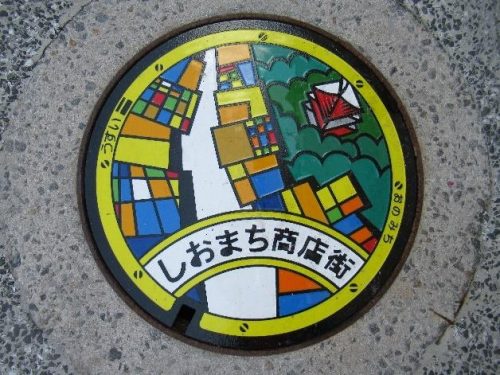
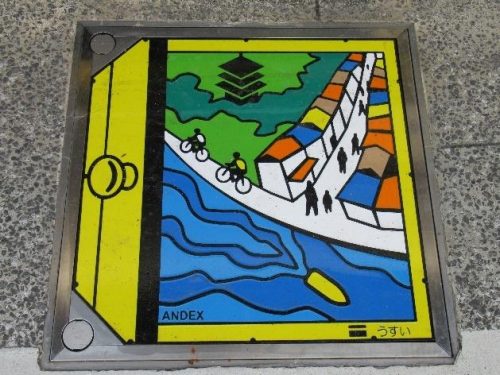
I reached the end of the shopping street and was disappointed at finding zero restaurants I wanted to try. This was actually familiar territory as I spent the night in this area three and a half years ago, and I truly remember there being more options to eat. I eventually stumbled upon Shimanami Roman, a cozy and affordable joint that serves up some unique dishes such as this lemon pork rice bowl.
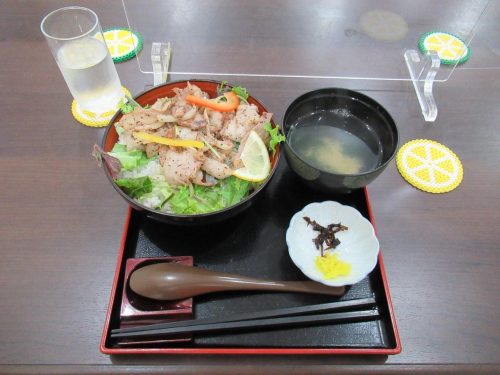
With my belly full once again, it was time to hit the old dusty trail. My rear end was hurting badly from all the time spent on my bicycle seat, but standing while pedaling from time to time alleviated the pain. Before long, I would be crossing the Tatara Bridge, where the border between Hiroshima and Ehime Prefectures lies.

Simply going up the incline that would lead to the bridge was grueling, but on my way up, I took some time to appreciate the local agriculture. It’s common knowledge in this part of Japan that Hiroshima Prefecture is famous for lemons and Ehime Prefecture renowned for oranges, but here they were, growing side by side. I saw it as a microcosm of the Shimanami Kaido as a whole, and the thought of it pressed me to hurry closer to the fated line.
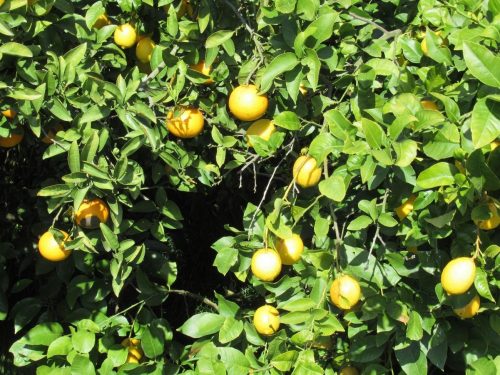
Joy in Ehime: Pushing the Limit
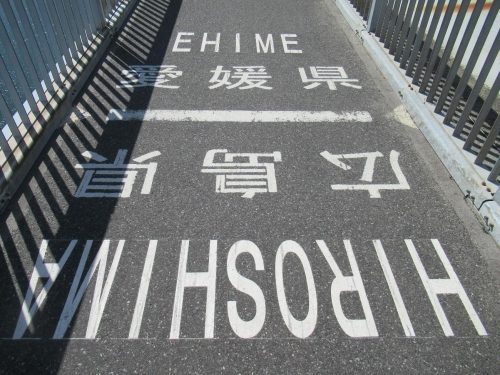
There it was, the dividing line indicating the terminus of each prefecture, spray painted onto the road. As soon as I tread over this line, I would be traveling in Ehime Prefecture, an area outside the scope of this website. This has without a doubt been the longest trip I have taken for the sake of an article, and chronicling my deeds in Imabari makes me a pioneer of sorts. Since this article (and the website as a whole) revolves mainly around Hiroshima Prefecture, and I didn’t have as much time on the latter three islands anyway, there won’t be as much info for each island from here on out, but I attempted to see what I could. For starters, the first point of interest upon crossing the border is the Roaring Dragon gimmick right on the Tatara Bridge.
The pillars of the Tatara Bridge are shaped like tuning forks, so if one stands under either of them and claps one’s hands, the sound bounces off the top and sides of the pillar, creating a mysterious echo. The effect can be amplified when using the wooden clappers provided, as can be heard in the above video. This was a solo trip and I couldn’t flag down anyone to record me, so I balanced my camera on my bicycle seat and had to try several takes before I finally got good footage of myself clapping.
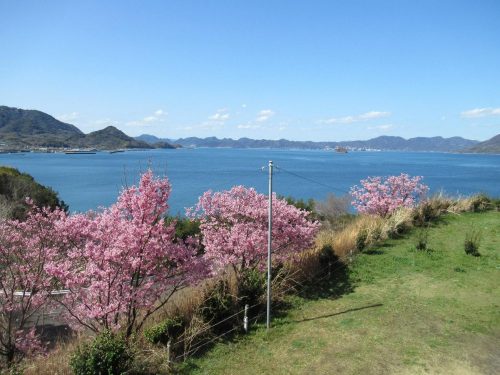
When I got to the end of the bridge, the road started spiraling down to street level, but along the way, I caught sight of some bright pink trees. The sakura seemed to be doing swell over here in Imabari by the looks of things, and not too far from these trees were some people camped out and taking it easy while quietly watching the waves. I figured that since I still had plenty of daylight, I would seek out one tourist site on Omishima before hauling tail to the finish line.
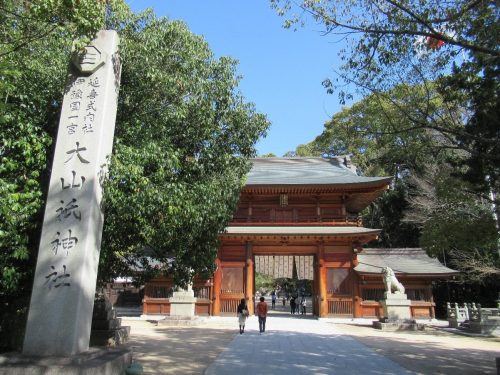
It felt like an eternity of confirming the right directions on my map application and getting lost in the middle of nowhere, but somehow, I made it to my destination, Oyamazumi Shrine. I had previously not heard of it until I found it in a travel guidebook one day, so I decided to give it a go. All I did here was walk along the shrine grounds, though; I didn’t feel like I had time to partake in any rituals like I normally would.
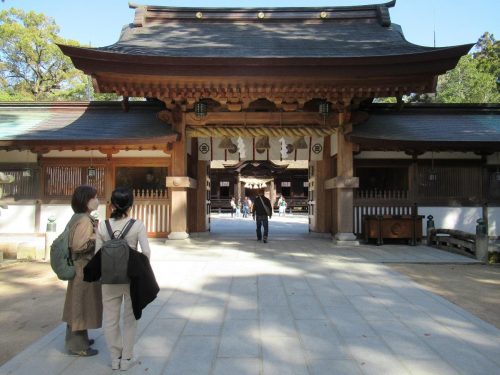
Oyamazumi Shrine seems to be a local favorite destination for nearby tourists, as there were lines to pray at the shrine’s main hall, and the parking lot outside was sufficiently filled. What little time I spent here I spent seated, free of the burden I had been carrying on my back this entire time. That in itself may have made this detour worth it.
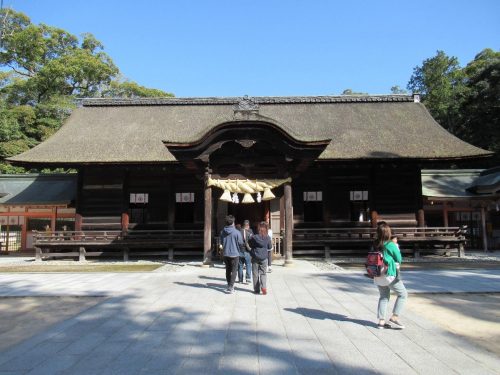
On my way back outside to the path from whence I came, I made a startling discovery. There was an unattended stand selling big bags of freshly-picked oranges for only ¥100 each! I had to resist the temptation to buy myself a bag because my backpack was heavy and bloated as it was; I simply had to tough it out until I could find dinner on Shikoku.
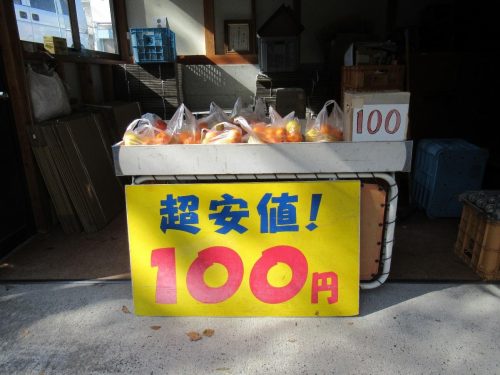
I came down a steep incline on my way to Oyamazumi Shrine, so it was a painstaking journey back up and I had to get off to walk my bike on several occasions. Once I was back on the main cycling road, I skedaddled over to the Omishima Bridge, which connects Omishima with Hakatajima. Comparatively, it’s not as impressive as the other bridges I encountered on this trek, but I guess that’s what makes it distinct.
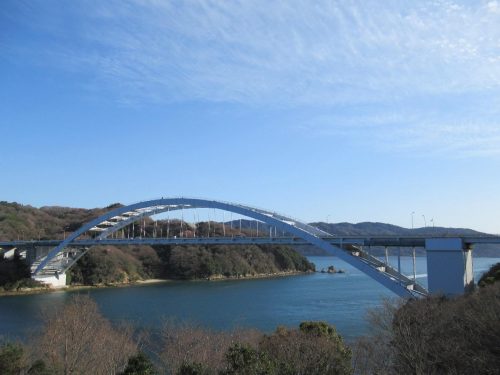
I’m not going to lie: at this point, I just wanted to get this ride over with so I could return the bicycle and take the bus home. Luckily, Hakatajima just might be the quickest island to zip through on the whole journey. There are sites worth seeing, such as Hirakiyama Park (which allegedly sports lots of cherry trees as well) and Dolphin Farm Shimanami, but I suppose those are best reserved for a trip that concentrates more on Imabari than Onomichi. This time, it was straight to the Hakata Oshima Bridge which connects the fifth and sixth islands.

Oshima (大島) translates to “big island,” and that’s no misnomer given how long it takes to bike from one end of the island to the other. Notable stops here include–and are definitely not limited to–the Murakami Pirates Museum and Roadside Station Yoshiumi Iki-iki-kan, where visitors can sit down with a meal or snack, and even buy fresh seafood to grill themselves. I did stop at the roadside station to rest my aching body before taking on the final boss–the Kurushima Kaikyo Bridge. It was getting dark fast, which meant I was either racing against time to catch my bus home or looking for some place in Imabari to put me up for one more night, so this was the last photo I took of my voyage.
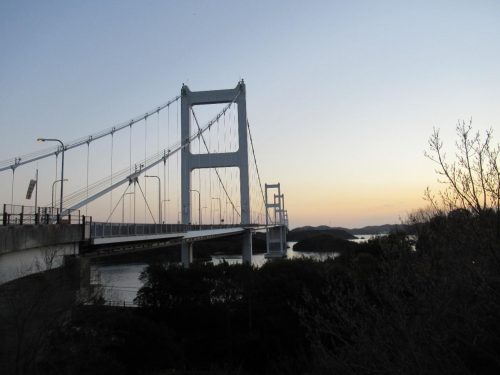
Spanning a total length of 4,015 meters, the Kurushima Kaikyo Bridge was definitely something I wasn’t prepared for, but there was no other way to go except straight ahead. My body was getting weaker by the minute, which made me slow as molasses, and the sun actually set while I was still on the bridge. It was pitch black when I touched down on Shikoku, and even with the lamp attached to the bike, navigating the streets of Imabari at night proved to be a challenge. Let me wrap up this episode by simply saying: Imabari Station has lots of hotels nearby, so don’t be anxious about not catching the last bus of the day. As for returning your bike, if you show up to the terminal after business hours, call the appropriate number listed on the important papers you were given at the beginning (and must return along with the bicycle) and they’ll tell you what to do.
It was my second time attempting the Shimanami Kaido by bicycle (but my first time doing it solo), and I ended it with two strikes. When all’s said and done, though, I don’t regret taking it slow in the name of savoring the sakura from Onomichi all the way to Imabari, and I’d do it all over again (just putting aside two nights next time). For the record, there’s absolutely no pressure to go all the way (a large chunk of tourists only go a fraction of the way), so even exploring only the islands on the Onomichi side may be a desirable plan. Between walking through seven temples and biking across six islands, a springtime vacation in Onomichi justifies a full weekend, if not more. Onomichi as a whole is chock full of sakura, so if one corner of the city doesn’t have them, you’ll find another place that will, if you look hard enough. Considering how much fame this area has garnered for its scenery, you won’t regret any time or physical effort put into scoping out the true beauty of Hanamichi Onomichi!
Written by the Joy in HIROSHIMA Official Team
